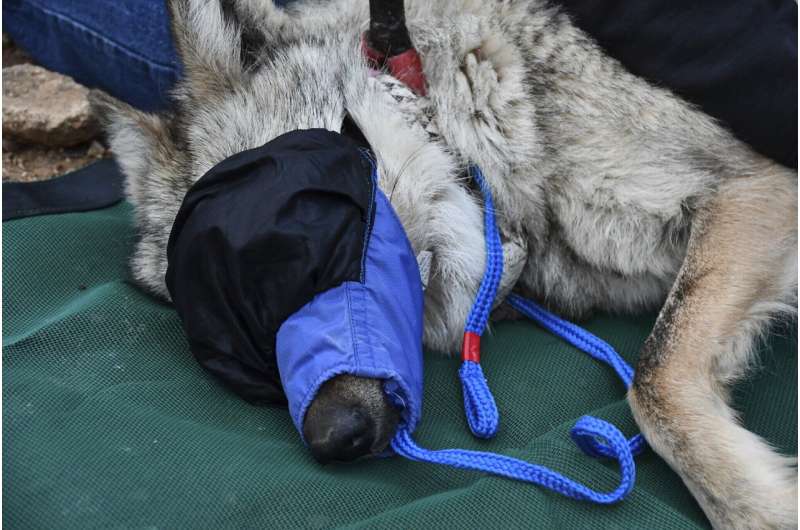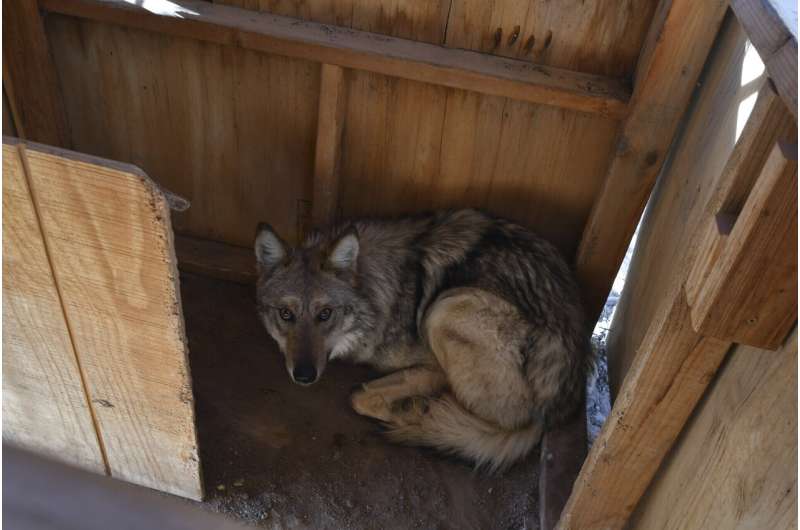This article has been reviewed according to Science X's editorial process and policies. Editors have highlighted the following attributes while ensuring the content's credibility:
fact-checked
reputable news agency
proofread
Biologists are keeping a close eye on a rare Mexican wolf that is wandering out of bounds

Northern New Mexico or bust—that seems to be the case for at least one Mexican gray wolf that is intent on wandering beyond the boundaries set for managing the rarest subspecies of gray wolf in North America.
Federal and state wildlife managers confirmed Thursday that the endangered female wolf has traveled north of Interstate 40 and beyond a recovery zone that spans parts of southwestern New Mexico and southeastern Arizona. It was documented crossing the interstate west of Albuquerque last week and most recently was tracked to a mountainous area west of Jemez Springs.
This marks the second time the wolf—identified as F2754—has ventured north. It reached the foothills of the Rocky Mountains near Taos, New Mexico, last winter before it was caught and released back into the wild in Arizona.
Both state and federal wildlife managers said they were monitoring the wolf's movements and have yet to decide whether it will be captured again and relocated.
Environmentalists were excited about the wolf's journey, saying the animals have a natural inclination to roam and that this illustrates the species can thrive outside what they consider arbitrarily designated boundaries in New Mexico and Arizona.
Legal challenges are pending in federal court that focus on the rules governing wolf recovery, namely the federal regulation that requires the U.S. Fish and Wildlife Service to remove all Mexican wolves north of Interstate 40, even in cases where the wolf causes no inconvenience or loss. The environmental groups contend in complaints filed last year that the provision ignores science.

Bryan Bird, the Southwest program director with the environmental group Defenders of Wildlife, suggested that the female wolf is in search of a mate and might find one in Colorado.
"This is a clear sign that wolves will again roam from the northern Rockies in Canada to the Sierra of Mexico if we let them," he said in a statement.
Ranchers in New Mexico and Arizona who have long complained that wolves are responsible for dozens of livestock deaths every year are concerned about any expansion of the wolves' range.
"We urge New Mexicans who are not accustomed to having the Mexican wolf in their backyard to exercise caution, especially for vulnerable children, pets and livestock in rural areas," said Loren Patterson, president of the New Mexico Cattle Growers' Association. "Regrettably, this is another installment of what we can expect in the future."
The latest survey results released earlier this year by the U.S. Fish and Wildlife Service show there were at least 241 Mexican wolves roaming the southwestern U.S., marking the seventh straight year that the numbers have trended upward. Federal wildlife managers also documented more breeding pairs and pups last winter than in any year since reintroduction efforts began more than two decades ago.
© 2023 The Associated Press. All rights reserved. This material may not be published, broadcast, rewritten or redistributed without permission.




















